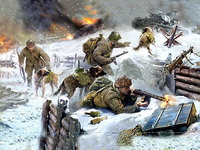In any case, I questioned the officer about the conditions of service. It turned
out that the food was sufficient enough.
The trainers were issued 300 grams of crackers per day. The dogs were fed with
boiled horsemeat, which was edible to humans as well, and bread – 800 grams in
total.
Working with dogs did not frighten me as I was from the countryside. In my
childhood, there was always a dog in our yard, and so I agreed to the transfer.
The new battalion was also located in Leningrad, and I was assigned to be in
charge of an incomplete platoon, consisting of 8 dogs and as many soldiers.
|

Anti-tank dogs in a battle (contemporary drawing) |
The dogs were intelligent purebred collies. They were fed only after crawling
under the disabled tanks. This was repeated many times and was the most
essential part of the training.
After a couple of weeks, the battalion commander called me in and ordered me to
relocate the entire platoon to the village of Efimovskiy (approximately 90 km
from Leningrad), where another anti-tank dog training facility was located.
Due to lack of regular transport, we were ordered to travel to the facility by
using other means – either walking or hitch-hiking. I checked the map that the
facility was directly 90 km, but we traveled for three days.
On the road, the dogs were fed dry food (boiled potatoes mixed with bread), but
one of them did not survive the journey. She stopped eating and moving, and
eventually, she died.
I was really upset by the event as I was unable to perform the commander’s
assignment. I assembled my men and asked for their advice –“what should we do?”
One of them, an elderly man, suggested: "Let's take the dog from the nearest
village."
Since there were no other suggestions, I agreed and in the night, they stole the
dog from someone’s backyard.
Upon arrival to our destination, I reported to the battalion commander that all
dogs with trainers were fully accounted for and ready for the next task. After
listening to my report, he hugged me and even kissed me.
Then he went to inspect the dogs we delivered. He immediately noticed a stray
dog (obviously, not a purebred) and said, "What is this scarecrow?" This
resulted in revealing to him everything that happened.
The commander did not scold me, and just said that this stray dog was not
suitable for our purposes. It turned out he did not even hope to see my platoon,
so one can imagine how pleased he was to see our arrival.
I spent about three months in that assault battalion, and then I was called back to the Army 54 signal regiment, where I continued to serve under its direct specialty-commander communication unit.
In conclusion, I would like to note that the use of dogs against tanks was too costly, so after breaking the blockade of Leningrad, destroyer battalions were disbanded. The efficiency of using anti-tank dogs in World War II remains uncertain.
After 1942, the use of anti-tank dogs by the Soviet Army rapidly declined, and
training schools were redirected to producing more urgently needed mine-seeking
and delivery dogs.
However, training of anti-tank dogs continued after World War II until 1996
|